Biology II Lesson 2: The Kidneys
1/50
There's no tags or description
Looks like no tags are added yet.
Name | Mastery | Learn | Test | Matching | Spaced |
|---|
No study sessions yet.
51 Terms
What is the primary role of the kidney?
The primary role of the kidney is to filter your blood, ridding it of substances that it doesn't need. These substances can then be sent to the bladder as urine for excretion.
CRB True or false? Because the kidney is filtering the blood of any toxins, taking repeated doses of medications could lead to Analgesic Nephropathy (kidney failure due to Analgesic use).
True. Because the kidney is filtering the blood of any toxins, taking repeated doses of medications could lead to Analgesic Nephropathy (kidney failure due to Analgesic use).
CRB Explain the use of a Dialysis Machine for a patient in Kidney Failure.
A Dialysis Machine has a semipermeable membrane inside, and this can be used to remove wastes from the blood as it passes through the machine. The Dialysis Machine does the blood filtering in place of the failing kidneys!

Compare the primary functions of some of the main capillary beds in the kidneys: the vasa recta and peritubular capillaries.
The vasa recta is mainly responsible for delivering oxygen to the kidney tissue.
Peritubular capillaries are mainly responsible for recollecting nutrients from the nephron after filtration.
CRB True or false? The kidney actually is an example of a Portal System, with the first capillary bed as the Vasa Recta and Peritubular Capillaries and the second capillary bed in series as the Glomeruli.
False. The kidney actually is an example of a Portal System, with the first capillary bed in the Glomeruli and the second capillary bed in series as the Vasa Recta and Peritubular Capillaries.
The _________________ enters the Kidney, and the ___________________ exits the Kidney.
(A) Renal Artery, Renal Artery
(B) Renal Artery, Renal Vein
(C) Renal Vein, Renal Vein
(D) Renal Vein, Renal Artery
(B) Renal Artery, Renal Vein
The Renal Artery enters the Kidney, and the Renal Vein exits the Kidney.

CRB What are the smallest functional units of the Kidneys?
(A) Loop of Henle
(B) The Kidney itself
(C) The Nephron
(D) Renal Medulla
(C) The Nephron
The Nephron is the smallest functional unit of the Kidneys.
Which of the following roles of the kidney are nephrons responsible for?
I. Collection
II. Distribution
III. Filtration
(A) II only
(B) III only
(C) I and III only
(D) I, II and III
(C) I and III only
The nephron is responsible for the two major functions of the kidney: collection and filtration.
Compare the location of the renal medulla and the renal cortex.
The renal cortex is the outer layer of the kidney.
The renal medulla is the inner layer of the kidney.
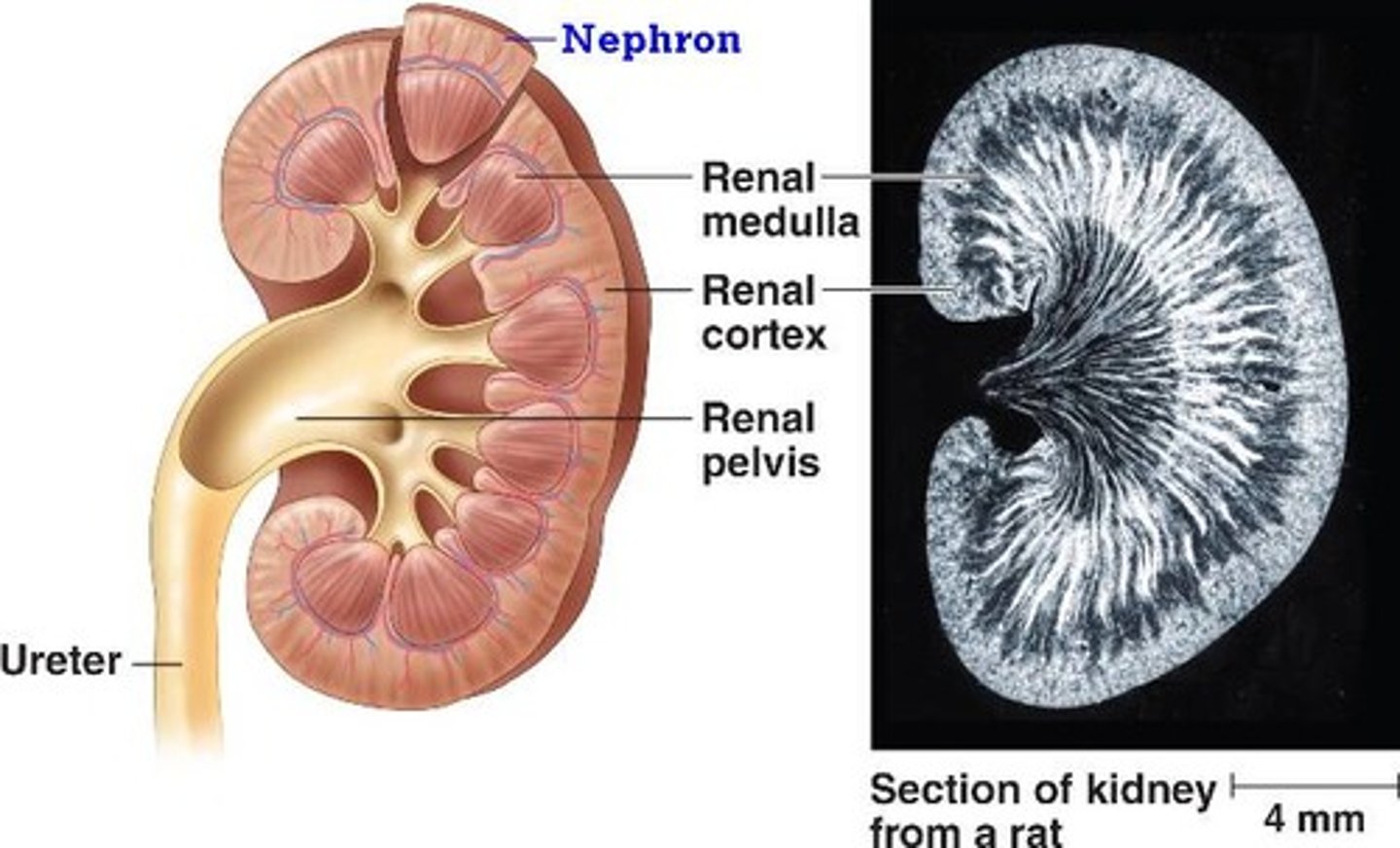
Compare the location and role of the renal calyces (sing. calyx) and the renal pelvis.
The renal calyces collect the urine from the collecting ducts of the nephrons.
The renal calyces then empty into the renal pelvis, the central area of the kidney which will drain into the ureter.
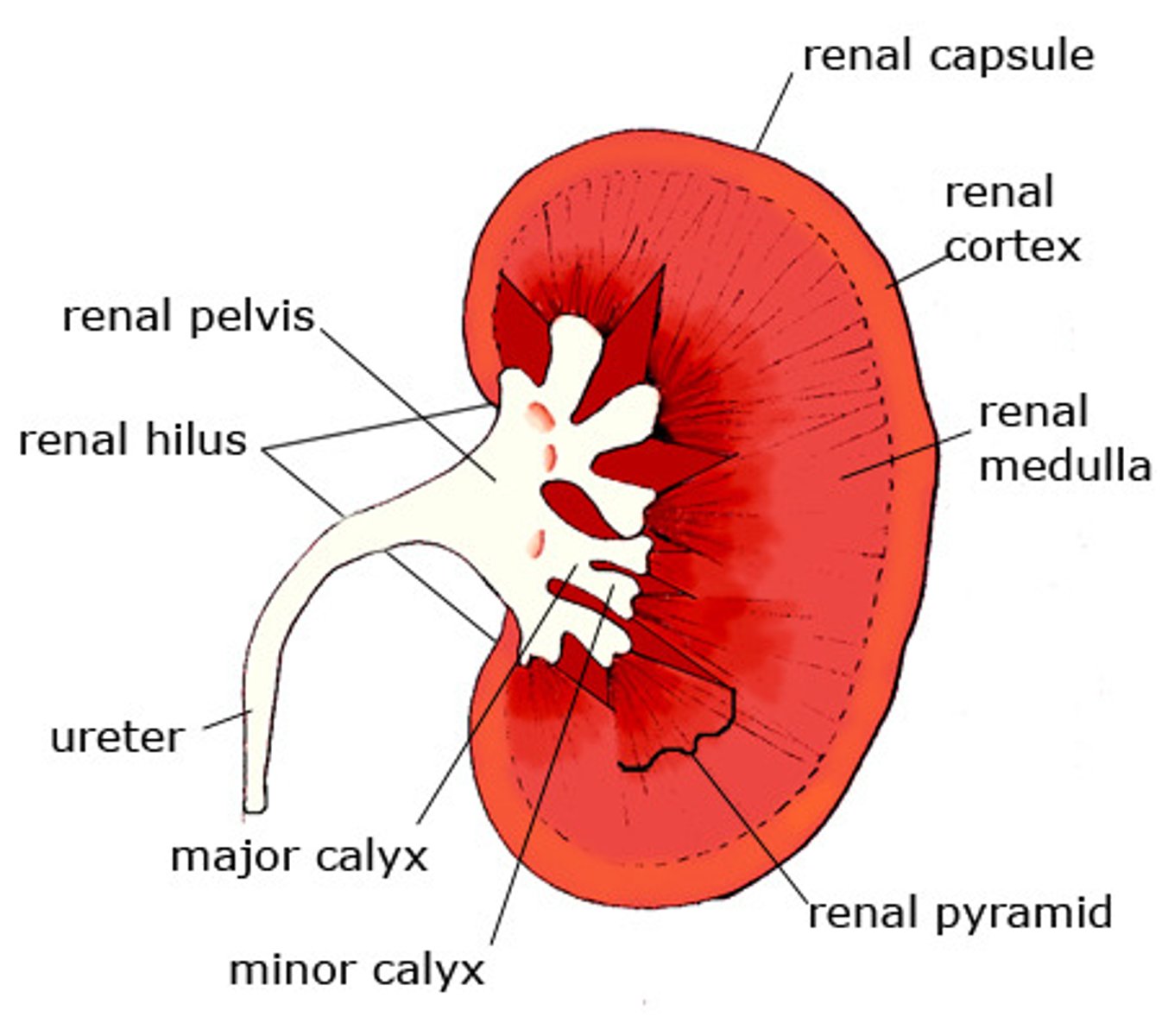
Which structures come out of the renal hilum?
I. Renal Artery
II. Renal Vein
III. Ureter
(A) I and II only
(B) III only
(C) I and III only
(D) I, II, and III
(D) I, II, and III
The renal artery, renal vein, and ureter make up the renal hilum as it exits the kidney.
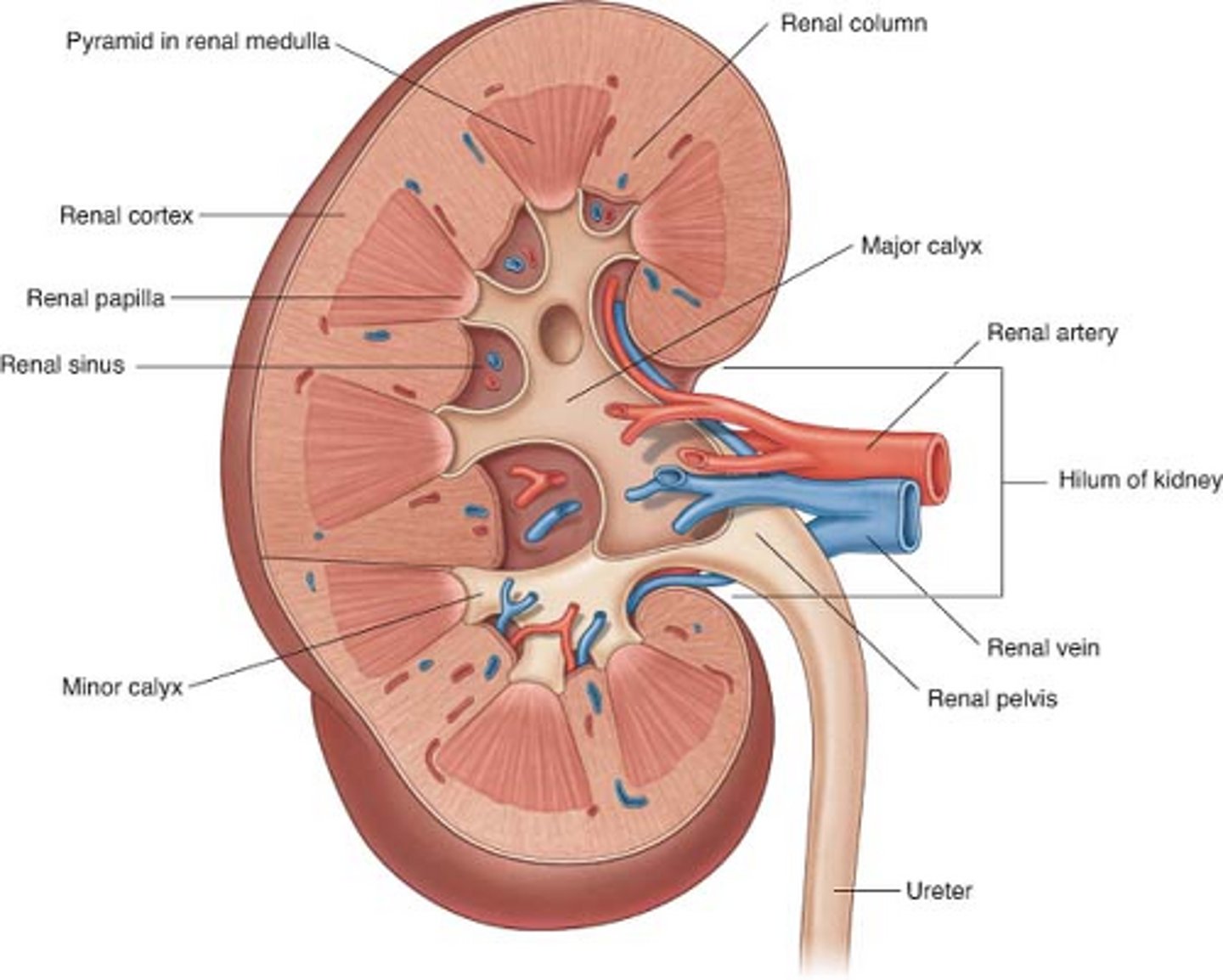
The kidney is responsible for maintaining the homeostasis of many things EXCEPT which of the following?
(A) Blood Pressure
(B) Osmolarity
(C) pH
(D) Temperature
(D) Temperature
The kidney is responsible for maintaining the homeostasis of blood pressure, osmolarity, pH, and waste products (i.e. urea).
Briefly describe the four main processes of the nephron:
(1) Filtration
(2) Reabsorption
(3) Secretion
(4) Excretion
(1) Filtration - Blood is filtered from the bloodstream into the nephron.
(2) Reabsorption - Substances that are wanted in the bloodstream are directly reabsorbed from the convoluted tubules back into the bloodstream.
(3) Secretion - Substances that are not wanted in the bloodstream are directly secreted into the convoluted tubules.
(4) Excretion - After the first three processes are complete, the remaining liquid is sent to the bladder for excretion (into the toilet).

Which of the following is the main site of filtration in the kidney?
(A) Distal convoluted tubule
(B) Loop of Henle
(C) Proximal convoluted tubule
(D) Glomerulus
(D) Glomerulus
The glomerulus is the main site of filtration.
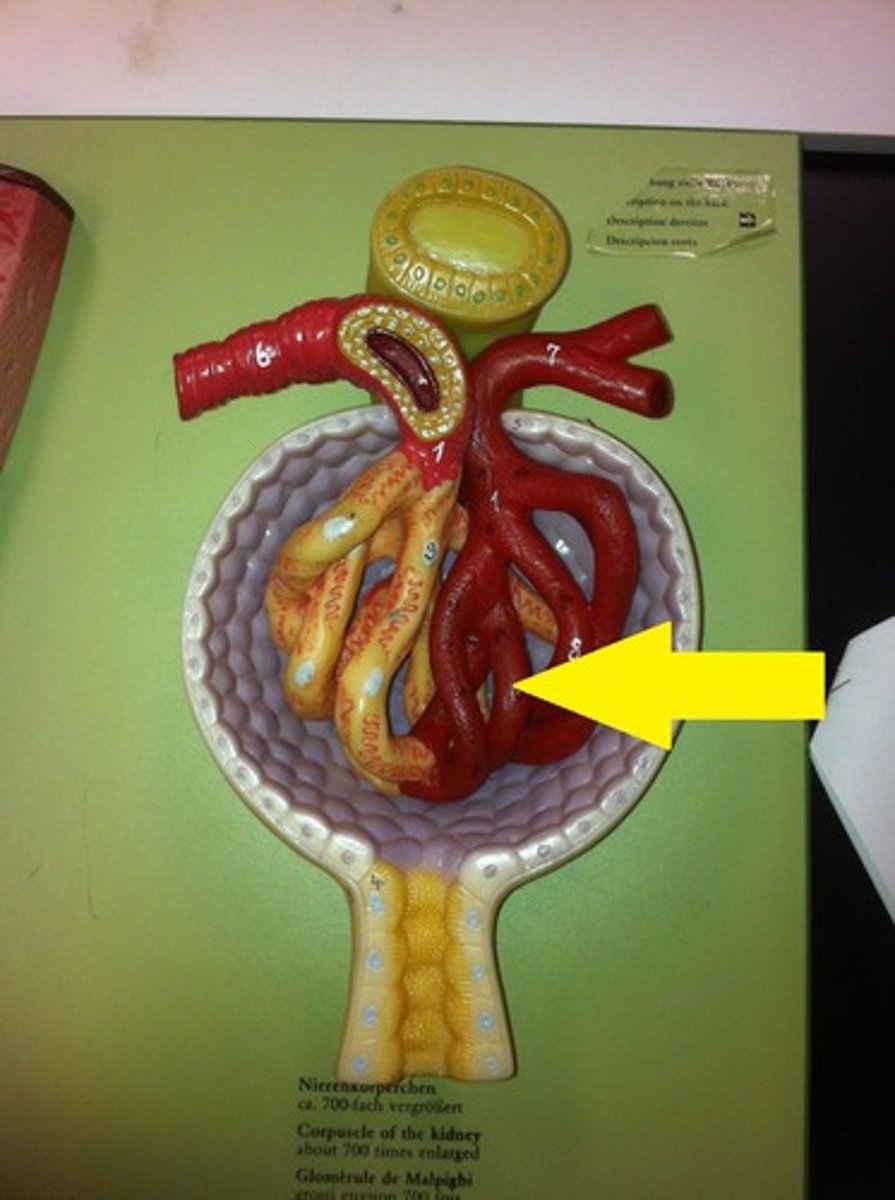
CRB True or false? Starling Forces account for the pressure differentials between the blood and Bowman's Space that cause this filtration.
True. Starling Forces account for the pressure differentials between the blood and Bowman's Space that cause this filtration.
CRB Which of the following are accounted for in Starling Forces?
(A) Hydrostatic Pressure
(B) Oncotic Pressure
(C) Both A and B
(D) Neither A nor B
(C) Both A and B
Starling Forces account for both Hydrostatic and Oncotic Pressures.
Compare the afferent versus efferent arterioles.
Afferent arterioles enter the glomerulus, and efferent arterioles exit the glomerulus.

What is the order of the parts of the nephron from first to last in terms of the direction of fluid flow?
I. Distal convoluted tubule
II. Proximal convoluted tubule
III. Collecting duct
IV. Bowman's Capsule
V. Loop of Henle
(A) IV > V > II > I > III
(B) IV > I > II > V > III
(C) IV > II > V > I > III
(D) IV > V > I > II > III
(C) IV > II > V > I > III
The order of the parts of the nephron from first to last in terms of the direction of fluid flow is as follows:
Bowman's Capsule > Proximal convoluted tubule > Loop of Henle > Distal convoluted tubule > Collecting duct

CRB Draw out the structure of the nephron, labeling each of the following structures:
I. Distal convoluted tubule
II. Proximal convoluted tubule
III. Collecting duct
IV. Bowman's Capsule
V. Loop of Henle

Match the following parts of the nephron to their location, either in the renal cortex or renal medulla.
1) Distal convoluted tubule
2) Proximal convoluted tubule
3) Collecting duct
4) Bowman's Capsule
5) Loop of Henle
1) Distal convoluted tubule -> Renal Cortex
2) Proximal convoluted tubule -> Renal Cortex
3) Collecting duct -> Renal Medulla
4) Bowman's Capsule -> Renal Cortex
5) Loop of Henle -> Renal Medulla

The fluid that is filtered in the glomerulus empties into which of the following structures?
(A) Bowman's Capsule
(B) Loop of Henle
(C) Proximal convoluted tubule
(D) Glomerulus
(A) Bowman's Capsule
The glomerulus is the main site of filtration and the filtrate empties into bowman's capsule.

Which of the following are able to leak out of the glomerulus into bowman's capsule?
I. glucose
II. sodium ions
III. proteins
(A) I Only
(B) I and II Only
(C) II and III Only
(D) I, II, and III
(B) I and II Only
Proteins are too large to leak out of the glomerulus.
Why are ions, glucose and amino acids easily able to leak out of the glomerular capillaries when they are not able to leak out of capillaries elsewhere in the body? What makes the glomerulus different from a typical capillary?
The glomerulus is made up of fenestrated endothelial cells. These fenestrations (holes) allow the movement of larger molecules such as glucose and amino acids.
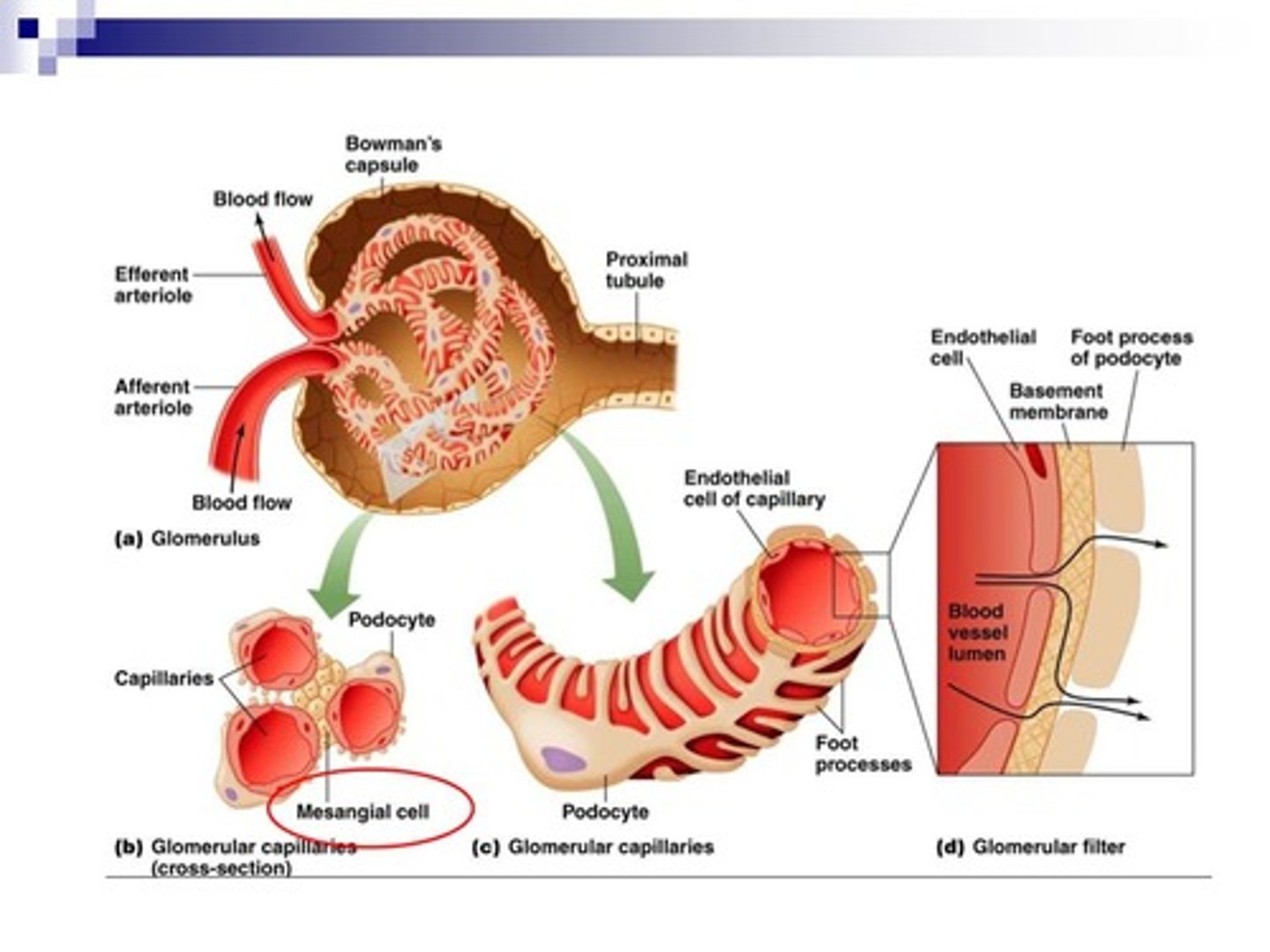
Wait a minute. If the glomerulus is fenestrated and has tons of holes, why aren't proteins able to leak out?
The glomerulus is surrounded by a basement membrane and only particles smaller than proteins can squeeze past.
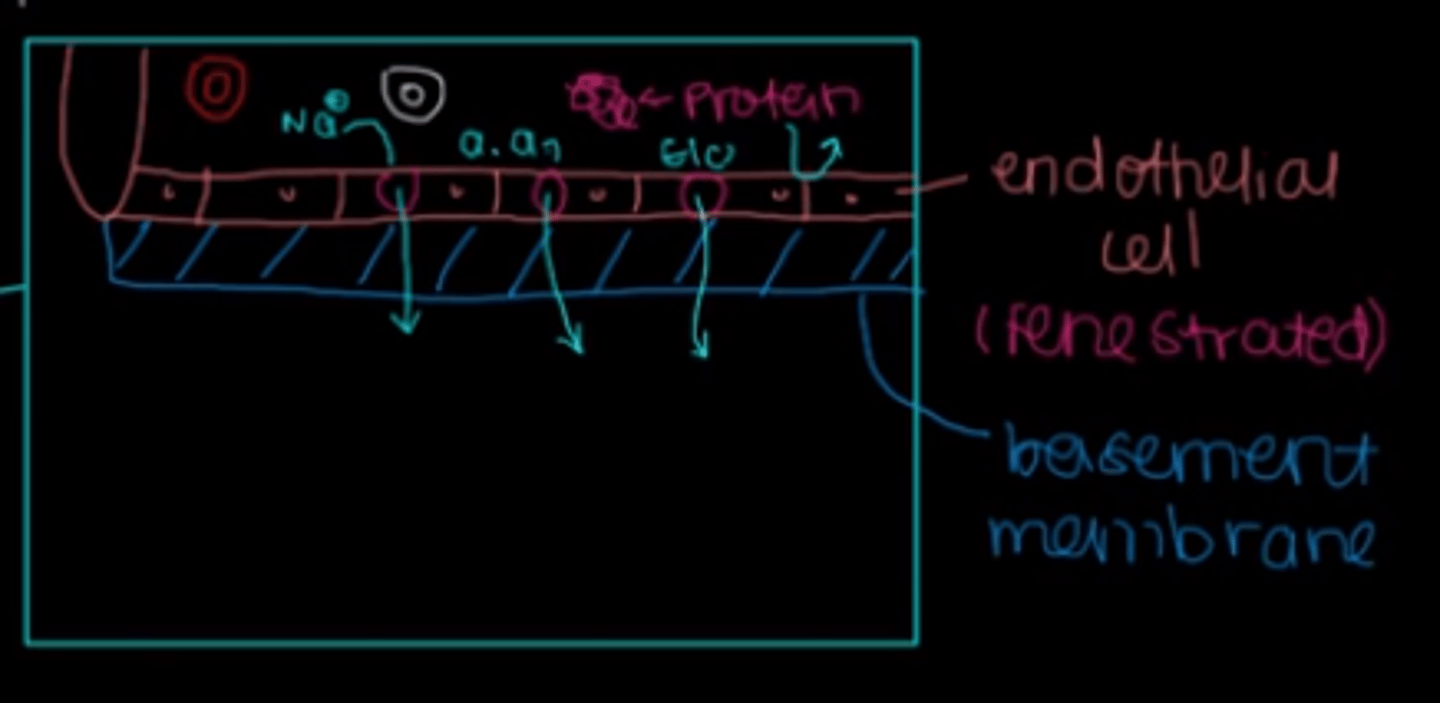
The glomerulus is also wrapped in the foot processes of cells known as:
(A) endotheliocytes
(B) podocytes
(C) nephrocytes
(D) glomerulocytes
(B) podocytes
The glomerulus is also wrapped in the foot processes of cells known as podocytes.
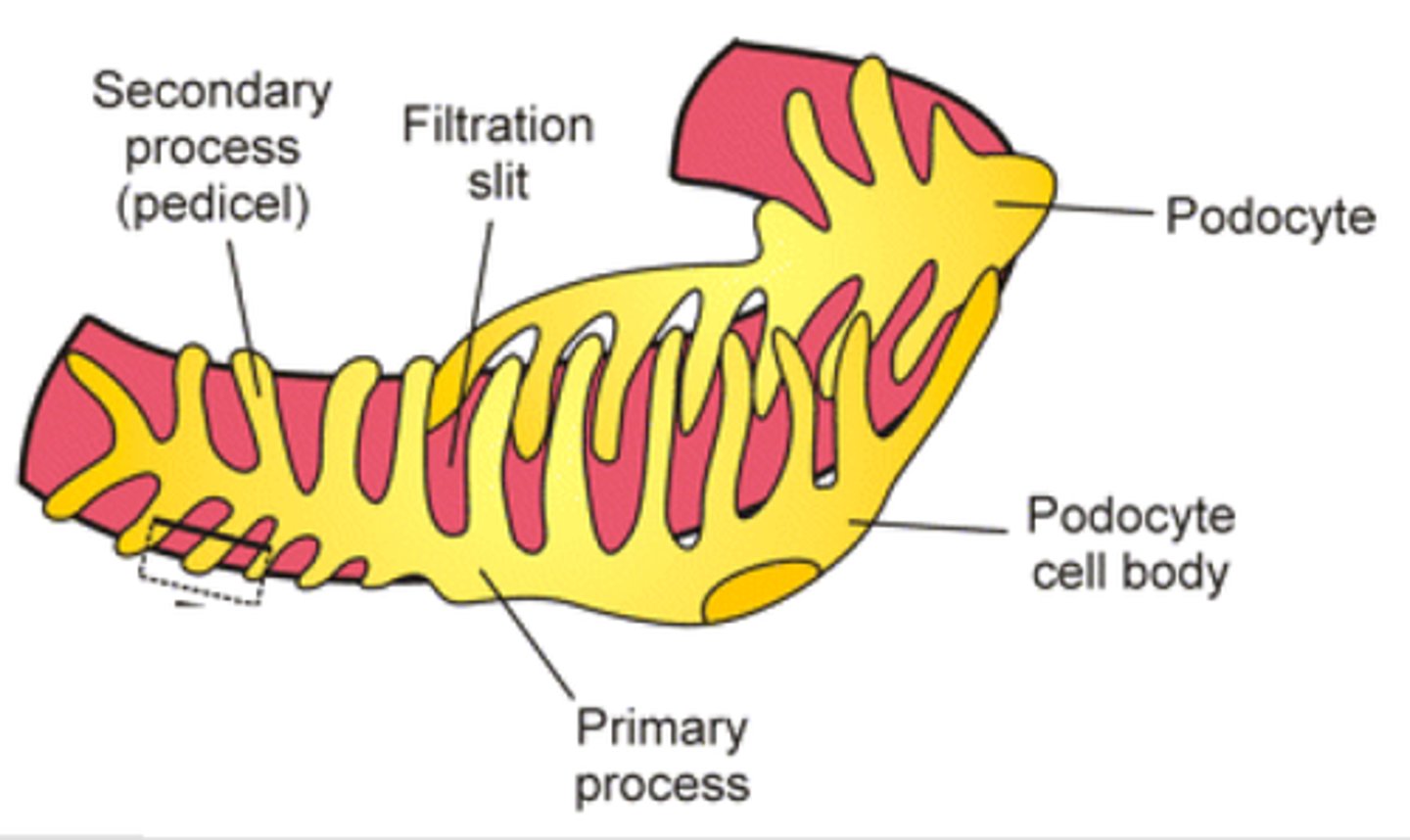
What happens to the filtration rate through the glomerulus:
- When the afferent arteriole is constricted?
- When the afferent arteriole is dilated?
- When the efferent arteriole is constricted?
- When the efferent arteriole is dilated?
- When the afferent arteriole is constricted, the filtration rate will decrease.
- When the afferent arteriole is dilated, the filtration rate will increase.
- When the efferent arteriole is constricted, the filtration rate will increase.
- When the efferent arteriole is dilated, the filtration rate will decrease.
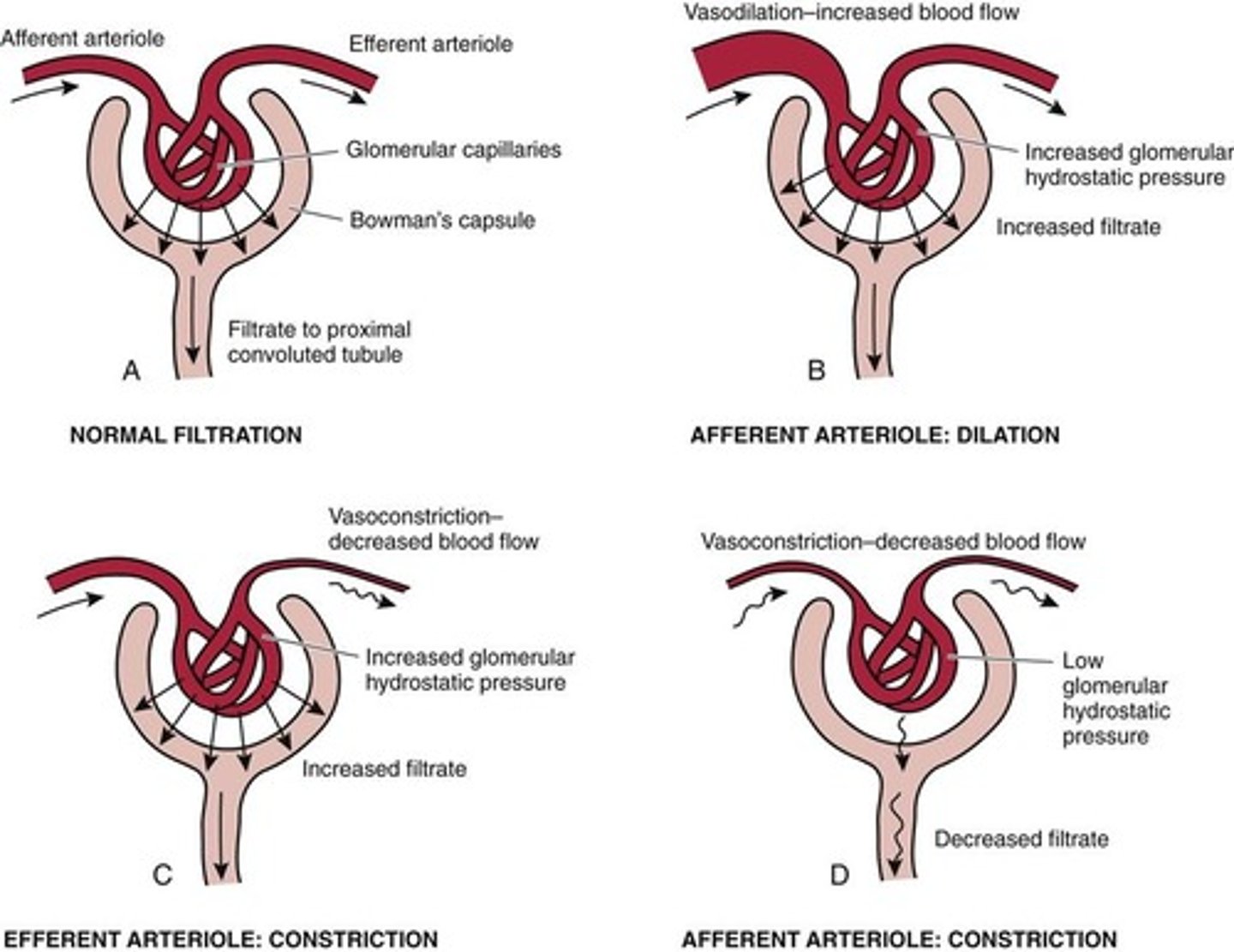
The epithelial cells lining the nephron have both an apical and basolateral membrane. What is the difference?
The apical membrane of the epithelial cells borders the lumen of the nephron.
The basolateral membrane of the epithelial cells borders the peritubular capillaries.

Where does the majority of reabsorption of key nutrients take place in the nephron?
(A) Collecting Duct
(B) Loop of Henle
(C) Proximal Convoluted Tubule
(D) Distal Convoluted Tubule
(C) Proximal Convoluted Tubule
65% of key nutrients are reabsorbed in the proximal convoluted tubule.
The countercurrent multiplication system takes place in which part of the nephron?
(A) Proximal Convoluted Tubule
(B) Loop of Henle
(C) Collecting Duct
(D) Distal Convoluted Tubule
(B) Loop of Henle
The countercurrent multiplication system takes place in the loop of henle.
The countercurrent multiplication system is based on the idea that _______________ is/are reabsorbed in the descending limb and _______________ is/are reabsorbed in the ascending limb. Explain why this allows for the absorption of a great deal of water.
The countercurrent multiplication system is based on the idea that water is reabsorbed in the descending limb and salts are reabsorbed in the ascending limb. By actively transporting salts into the interstitium, a high osmotic pressure is created. This high osmotic pressure will suck water out of the descending limb as the filtrate travels through it.

CRB In which part of the Nephron would you find the Diluting Segment, which has thicker lining of the tubules and can actually produce urine more dilute than the blood?
(A) Proximal Convoluted Tubule
(B) Ascending Loop of Henle
(C) Descending Loop of Henle
(D) Distal Convoluted Tubule
(B) Ascending Loop of Henle
The Ascending Loop of Henle has the Diluting Segment, which has thicker lining of the tubules and can actually produce urine more dilute than the blood.
What is the role of the juxtaglomerulus apparatus?
The role of the juxtaglomerular apparatus is to control blood pressure.
The juxtaglomerular apparatus sits next to which two structures of the nephron?
(A) Proximal Convoluted Tubule and Loop of Henle
(B) Descending Limb and Ascending Limb
(C) Distal Convoluted Tubule and Glomerulus
(D) Glomerulus and Loop of Henle
(C) Distal Convoluted Tubule and Glomerulus
The juxtaglomerular apparatus sits next to the distal convoluted tubule and the glomerulus.
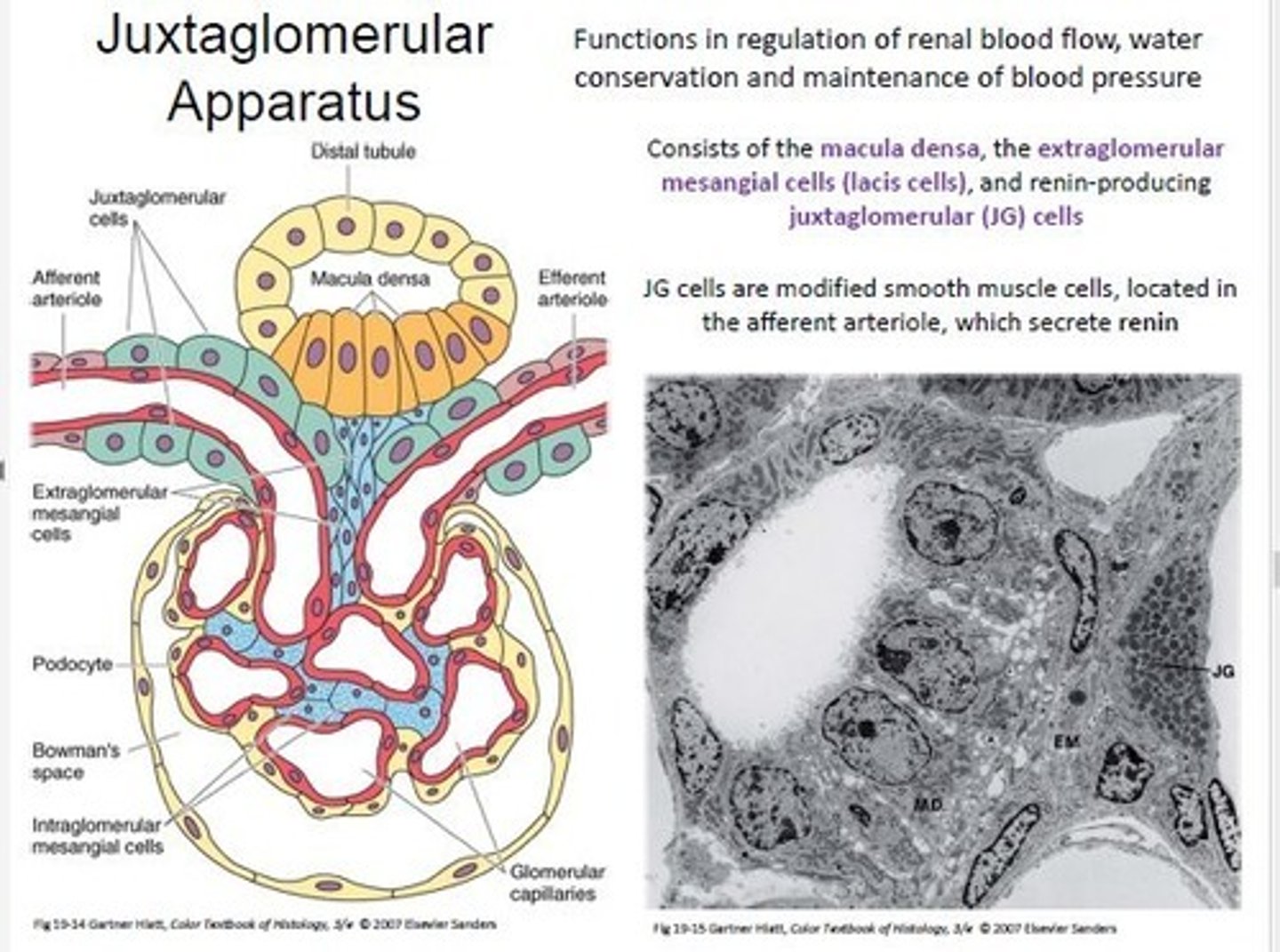
Match the following molecules as either being reabsorbed or being secreted in the proximal convoluted tubule.
1) HCO3-
2) Na+
3) H2O
4) Glucose + Amino Acids
5) K+
6) H+
7) Cl-
1) HCO3- -> Reabsorbed
2) Na+ -> Reabsorbed
3) H2O -> Reabsorbed
4) Glucose + Amino Acids -> Reabsorbed
5) K+ -> Reabsorbed
6) H+ -> Secreted
7) Cl- -> Reabsorbed

Match the following molecules as either being reabsorbed or being secreted in the distal convoluted tubule.
1) Ca2+
2) Na+
3) H2O
4) K+
5) H+
6) Cl-
1) Ca2+ -> Reabsorbed
2) Na+ -> Reabsorbed
3) H2O -> Reabsorbed
4) K+ -> Secreted
5) H+ -> Secreted
6) Cl- -> Reabsorbed
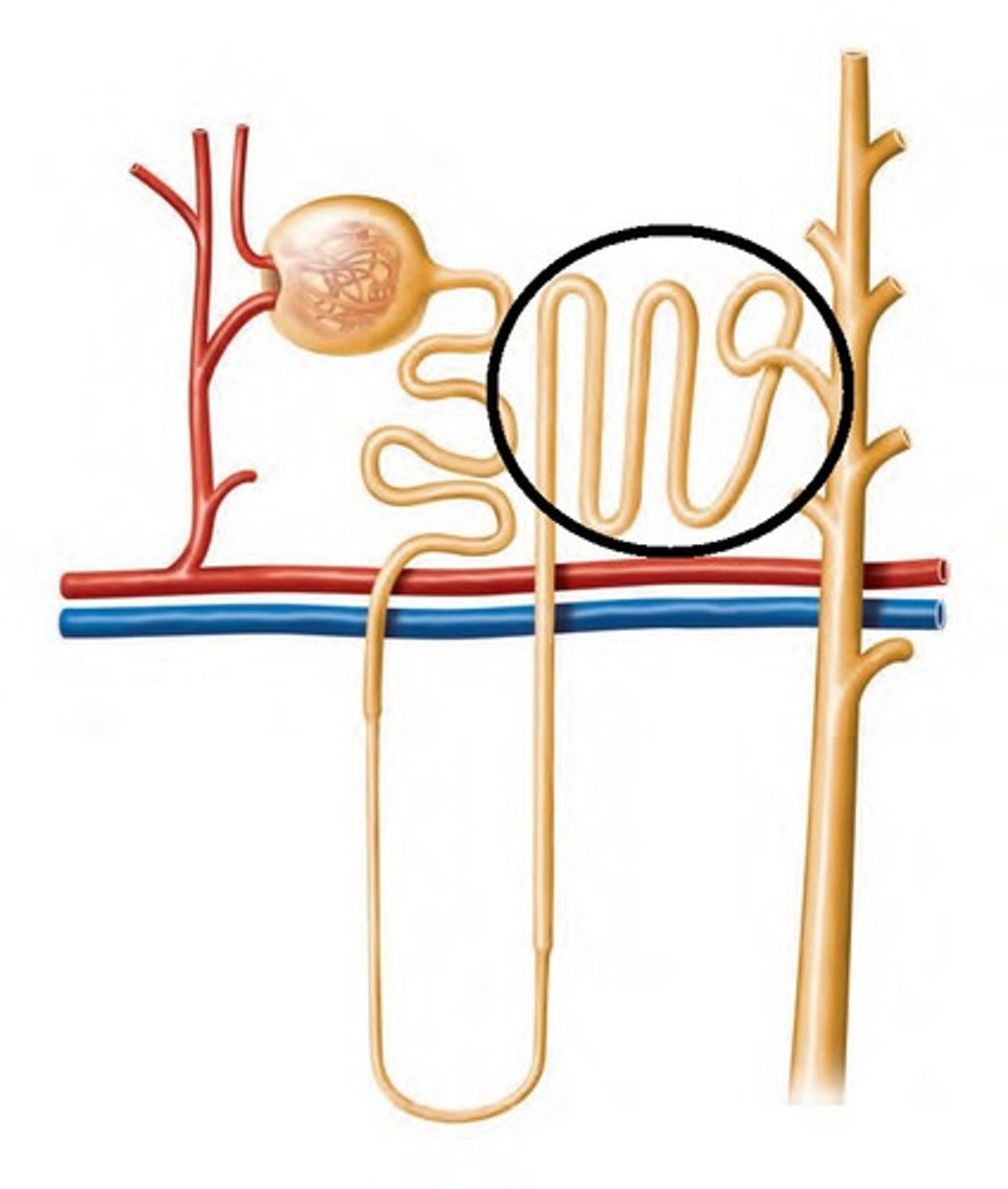
CRB Which of the following would you NOT expect to be excreted in high levels in the urine?
(A) Urea
(B) NH3
(C) CO2
(D) K+
(C) CO2
In the urine, you would expect Urea, NH3, H+ and K+ to be excreted in the urine.
In the basolateral membrane of the endothelial cells lining the proximal convoluted tubule, there are Na+/K+ ATPases that are pumping Na+ into the peritubular capillaries and K+ into the endothelial cells. This creates a low concentration of Na+ in the endothelial cell, allowing Na+ to passively diffuse from the lumen across the apical membrane into the endothelial cell. A symporter uses the energy from Na+ movement into the cell, to also transport a glucose molecule into the cell. The transport of glucose is an example of:
(A) Passive Diffusion
(B) Primary Active Transport
(C) Secondary Active Transport
(D) Osmosis
(C) Secondary Active Transport
The transport of glucose in this situation is an example of secondary active transport because the Na+/K+ ATPase uses energy to create a gradient that allows Na+ to passively diffuse into the cell, bringing glucose with it. The transport of glucose required energy indirectly.
Secondary active transport is a common transport mechanism used throughout the nephron to reabsorb a variety of compounds.
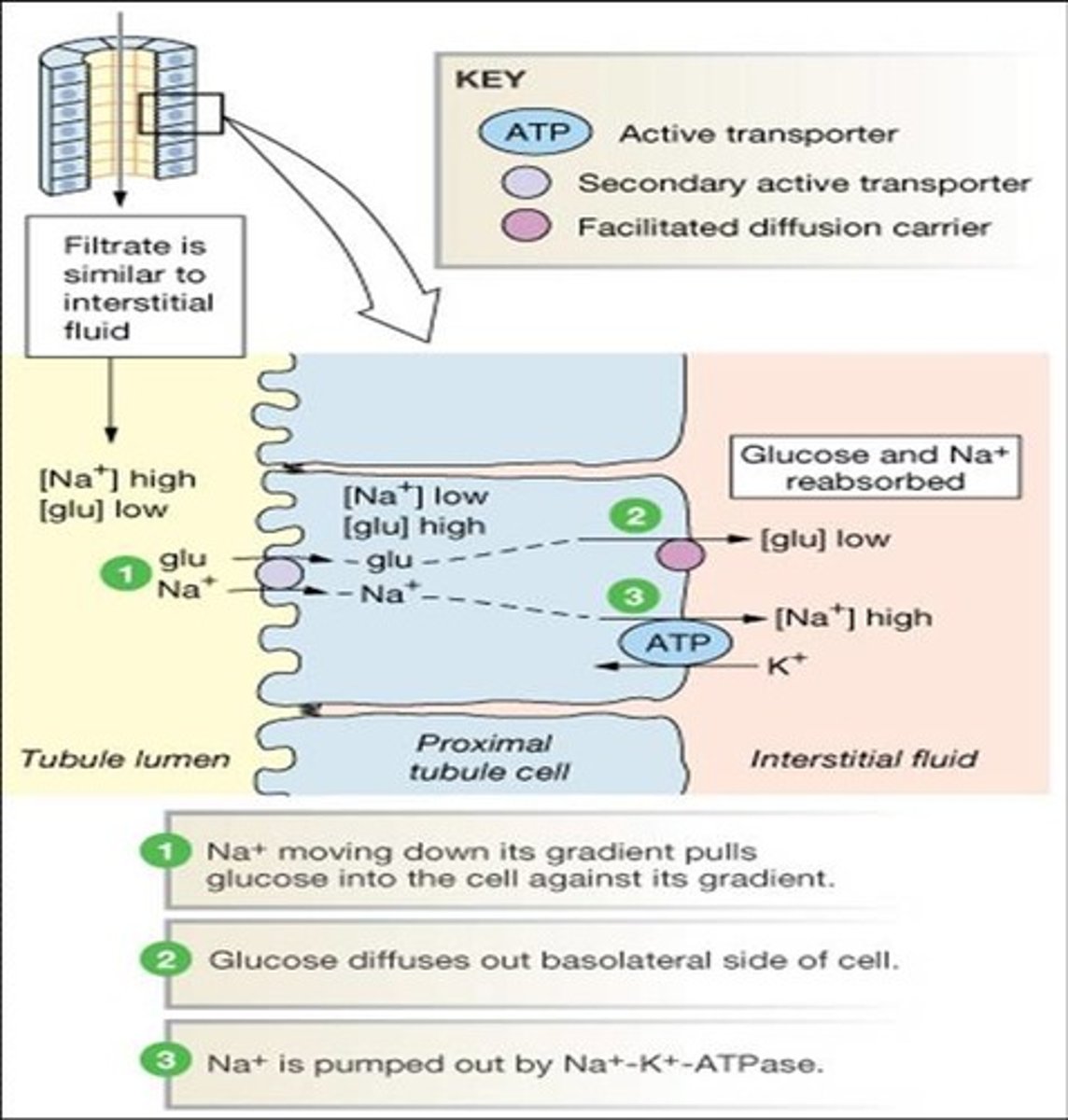
What is the primary substance that is reabsorbed in the collecting duct of the nephron?
(A) Na+
(B) K+
(C) H2O
(D) Glucose
(C) H2O
H2O is the primary substance that is reabsorbed in the collecting duct of the nephron.
If urea is a waste product, why is it sometimes reabsorbed in the medullary region of the collecting duct?
Sometimes urea is reabsorbed in the medullary region of the collecting duct in order to increase the osmotic pressure in the medullary interstitium to promote the absorption of more water.
The ureter has valves. Why?
The valves prevent the backflow of urine back into the kidneys.
Why is it important that the bladder is lined with transitional epithelium?
Transitional epithelium can expand, allowing you time to make it to the bathroom when your bladder is full.

CRB In the bladder/urethra, there are three main muscular structures. Which of the following is NOT one of them?
(A) Detrusor Muscle
(B) Internal Urethral Sphincter
(C) Internal Bladder Sphincter
(D) External Urethral Sphincter
(C) Internal Bladder Sphincter
The Detrusor Muscle, Internal Urethral Sphincter and External Urethral Sphincter are the 3 main muscular structures of the Bladder and Urethra.
CRB Fill in the blanks: The Internal Urethral Sphincter is made of __________________ ; the External Urethral Sphincter is made of ________________.
(A) Smooth muscle, Smooth muscle
(B) Skeletal Muscle, Skeletal muscle
(C) Smooth muscle, Skeletal muscle
(D) Skeletal muscle, Smooth muscle
(C) Smooth muscle, Skeletal muscle
The Internal Urethral Sphincter is made of Smooth Muscle; the External Urethral Sphincter is made of Skeletal Muscle.
CRB Compare the type of control that the Internal and External Urethral Sphincters are under.
Because the Internal Urethral Sphincter is made of Smooth Muscle, it is under autonomic control.
Because the External Urethral Sphincter is made of Skeletal Muscle, it is under voluntary control
Urination is scientifically known as:
(A) Masticulation
(B) Micturition
(C) Diurition
(D) Distillation
(B) Micturition
Urination is scientifically known as micturition.
The internal urethral sphincter is lined by ____________ muscle which is under _____________ control.
(A) skeletal, voluntary
(B) skeletal, involuntary
(C) smooth, voluntary
(D) smooth, involuntary
(D) smooth, involuntary
The internal urethral sphincter is lined by smooth muscle which is under involuntary control.
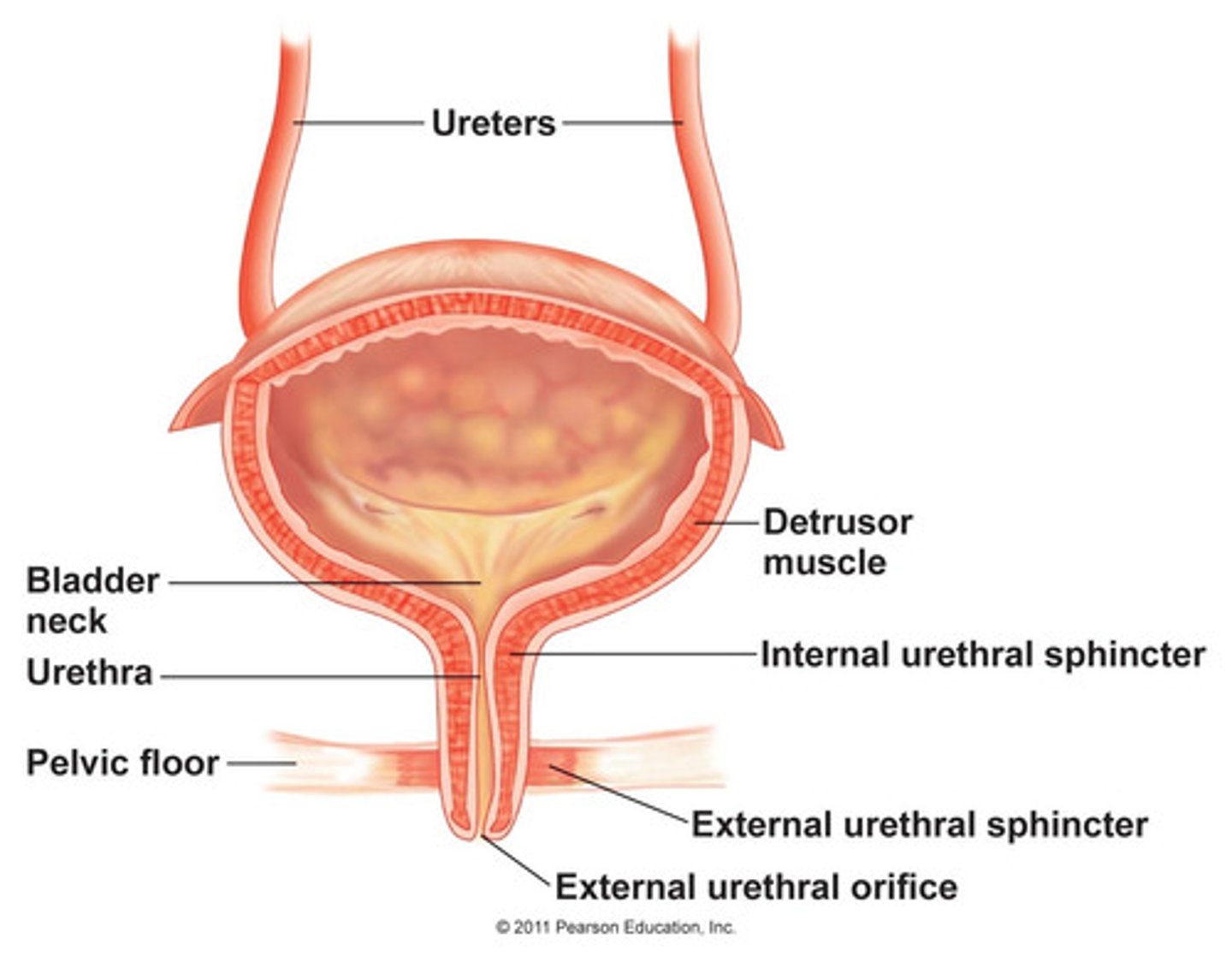
Males have which of the following urethra? Females?
- Prostatic
- Membranous
- Spongy
Males have a prostatic, membranous, and spongy urethra while females only have a membranous urethra.
Which of the following is the correct order of urethra in males?
I. Membranous
II. Spongy
III. Prostatic
(A) III > II > I
(B) II > I > III
(C) I > II > III
(D) III > I > II
(D) III > I > II
The following is the correct order of urethra in males:
prostatic urethra > membranous urethra > spongy urethra
What structures surround each of these urethra?
- Prostatic
- Membranous
- Spongy
- The prostatic urethra is surrounded by the prostate.
- The membranous urethra is surrounded by the external urethral sphincter.
- The spongy urethra is surrounded by the penis.
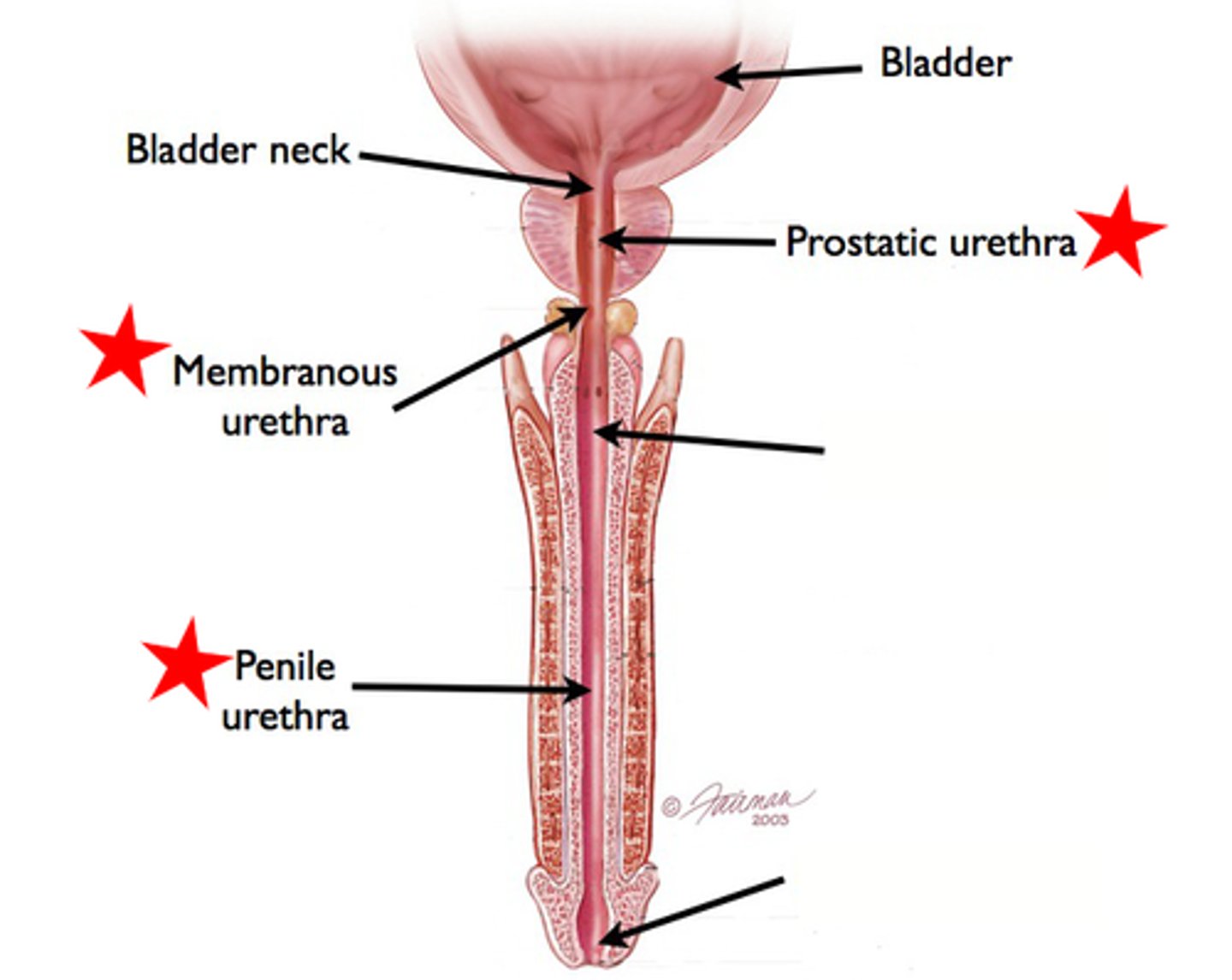
The external urethral sphincter is lined by ____________ muscle which is under _____________ control.
(A) skeletal, voluntary
(B) skeletal, involuntary
(C) smooth, voluntary
(D) smooth, involuntary
(A) skeletal, voluntary
The external urethral sphincter is lined by skeletal muscle which is under voluntary control.
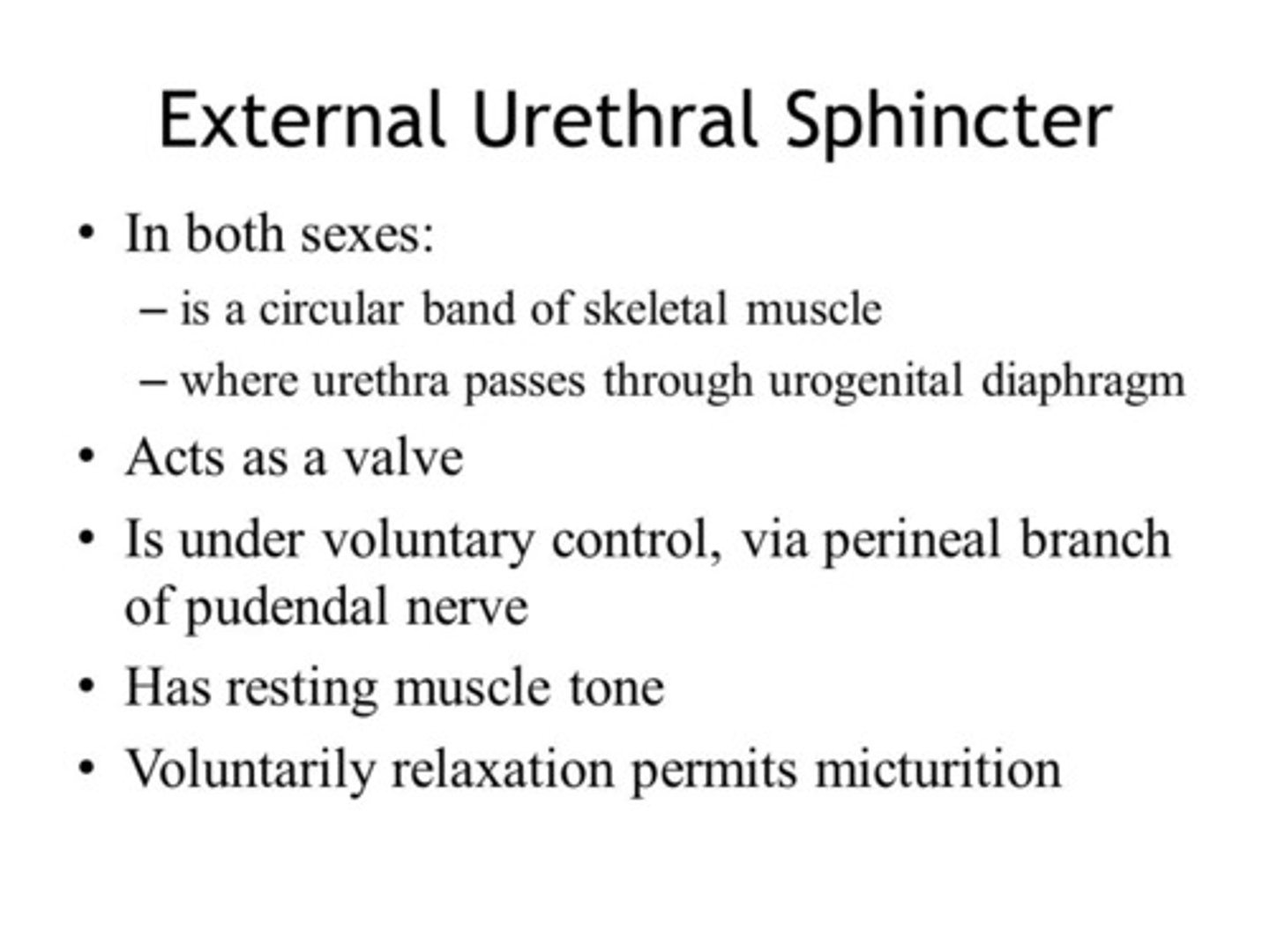
Do males or females have a greater chance at a urinary tract infection? Why?
Females have a higher risk of urinary tract infection because they have a shorter urethra. This means that there is a shorter path from the outside world to their bladder.